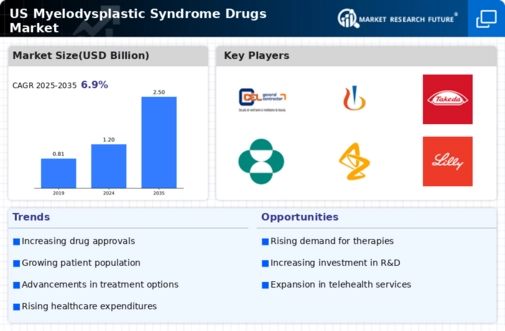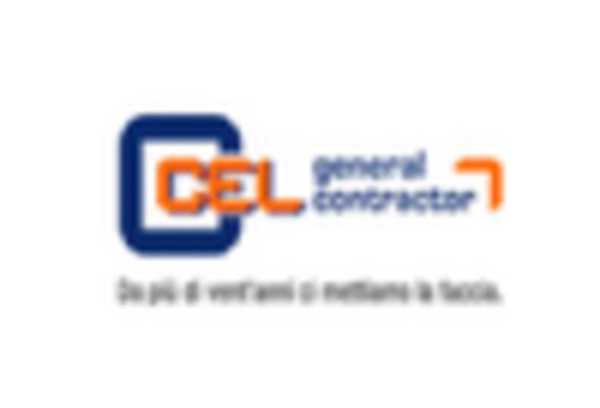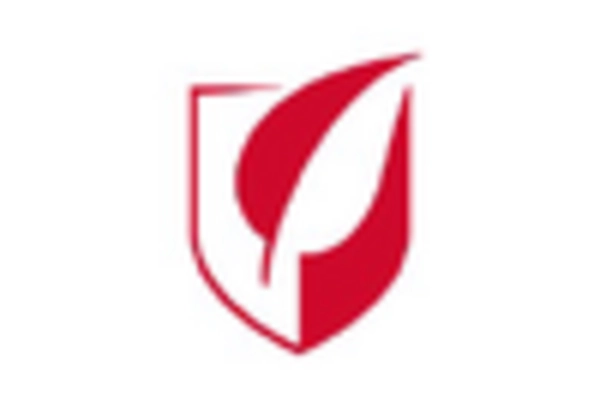Regulatory Incentives for Drug Approvals
Regulatory incentives for drug approvals are significantly influencing the myelodysplastic syndrome-drugs market. The US Food and Drug Administration (FDA) has implemented various programs aimed at expediting the approval process for innovative therapies targeting rare diseases, including MDS. Initiatives such as the Orphan Drug Designation and Breakthrough Therapy Designation provide developers with benefits like market exclusivity and reduced review times. These incentives encourage pharmaceutical companies to invest in research and development for MDS treatments, potentially leading to a surge in new drug approvals. As a result, the myelodysplastic syndrome-drugs market is likely to see an influx of novel therapies, enhancing treatment options for patients and driving market growth.
Growing Investment in Hematology Research
Investment in hematology research is a crucial driver for the myelodysplastic syndrome-drugs market. With funding from both public and private sectors, research initiatives are focusing on understanding the underlying mechanisms of MDS and developing targeted therapies. The National Institutes of Health (NIH) has allocated substantial resources to hematological research, which is likely to yield new insights and therapeutic options. Furthermore, collaborations between academic institutions and pharmaceutical companies are fostering innovation in drug development. This influx of investment not only accelerates the discovery of new treatments but also enhances the overall understanding of MDS, which could lead to improved patient outcomes. As research continues to advance, the myelodysplastic syndrome-drugs market is expected to benefit from a growing array of effective therapies.
Advancements in Drug Development Technologies
Technological advancements in drug development are significantly impacting the myelodysplastic syndrome-drugs market. Innovations such as high-throughput screening, artificial intelligence, and personalized medicine are streamlining the drug discovery process. These technologies enable researchers to identify potential drug candidates more efficiently, reducing the time and cost associated with bringing new therapies to market. For instance, the integration of AI in clinical trials has shown promise in optimizing patient selection and improving trial outcomes. As a result, pharmaceutical companies are increasingly investing in these technologies to enhance their drug pipelines. The potential for faster and more effective drug development could lead to a wider array of treatment options for patients with MDS, thereby expanding the myelodysplastic syndrome-drugs market.
Increased Awareness and Education Initiatives
Increased awareness and education initiatives regarding myelodysplastic syndromes are playing a pivotal role in shaping the myelodysplastic syndrome-drugs market. Organizations dedicated to hematological disorders are actively promoting awareness campaigns to educate both healthcare professionals and the public about MDS. These initiatives aim to improve early diagnosis and treatment, which is essential for better patient outcomes. As awareness grows, more patients are likely to seek medical attention, leading to higher demand for effective therapies. Additionally, healthcare providers are becoming more informed about the latest treatment options, which may influence prescribing practices. This heightened awareness is expected to drive growth in the myelodysplastic syndrome-drugs market as more patients are diagnosed and treated.
Rising Incidence of Myelodysplastic Syndromes
The myelodysplastic syndrome-drugs market is experiencing growth due to the increasing incidence of myelodysplastic syndromes (MDS) in the US. According to the National Cancer Institute, MDS affects approximately 4.5 per 100,000 individuals annually, with a notable rise in cases among older adults. This demographic shift is likely to drive demand for effective treatment options, as the aging population is more susceptible to hematological disorders. Consequently, pharmaceutical companies are focusing on developing innovative therapies to address this growing patient population. The rising incidence not only highlights the need for new drugs but also emphasizes the importance of ongoing research and development in the myelodysplastic syndrome-drugs market. As awareness of MDS increases, healthcare providers are more likely to diagnose and treat the condition, further propelling market growth.

















Leave a Comment